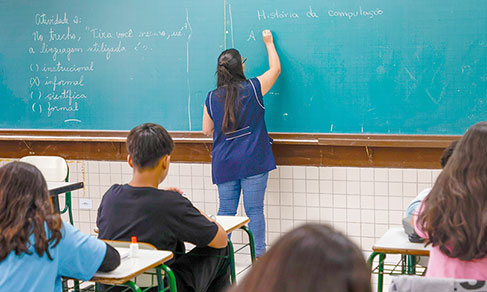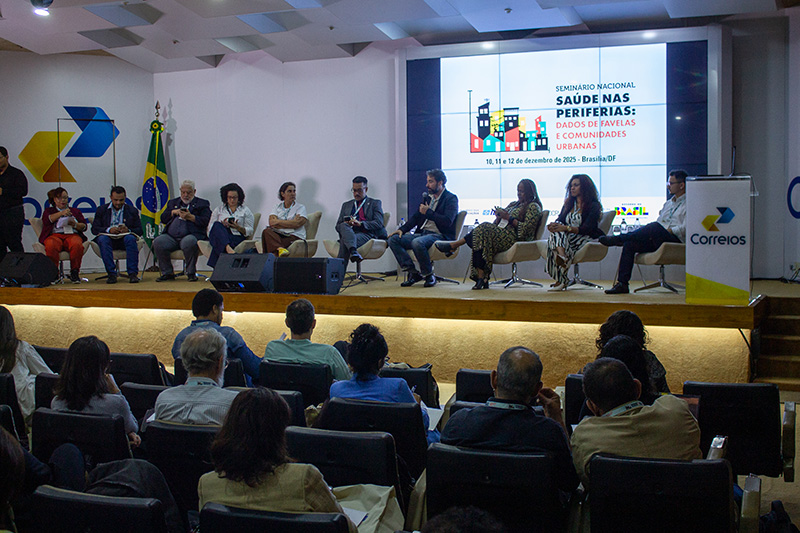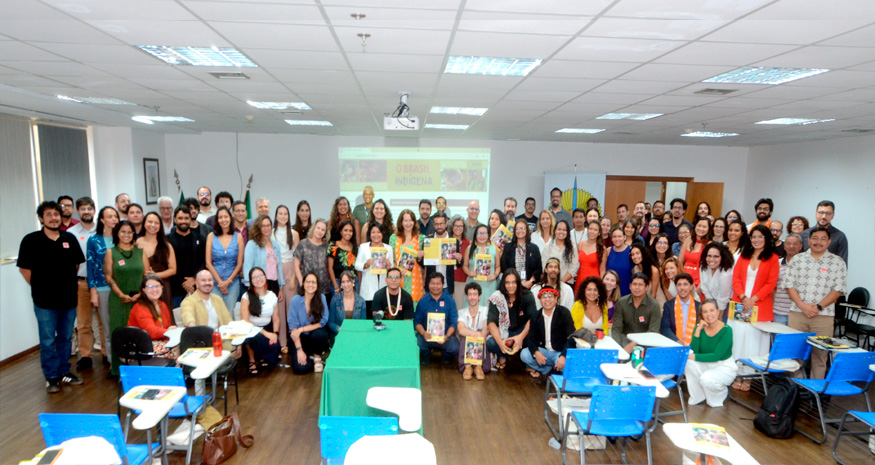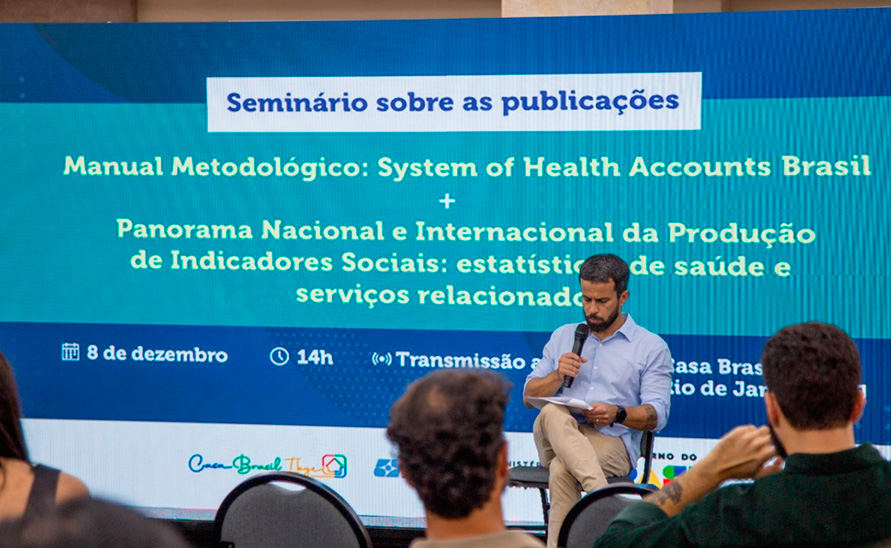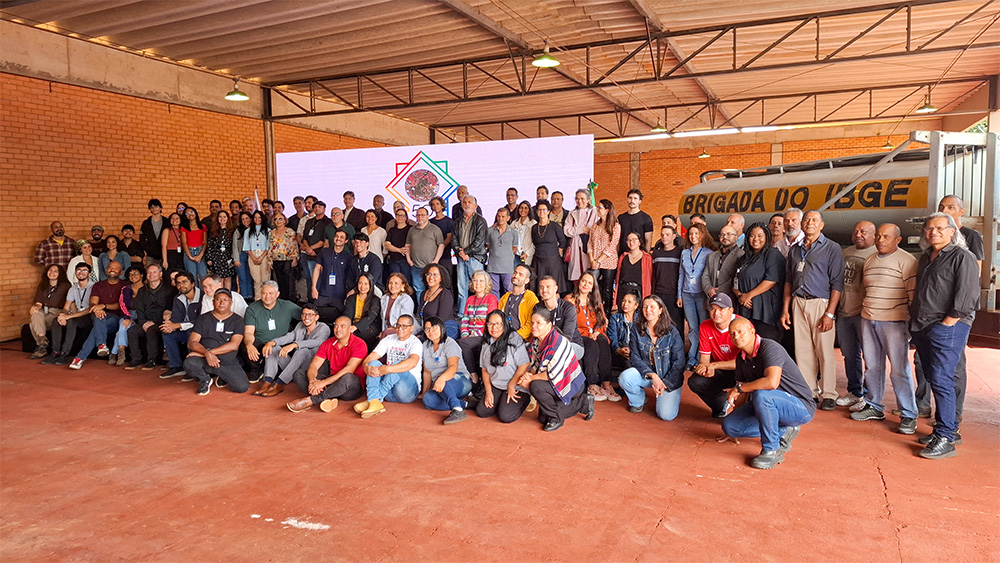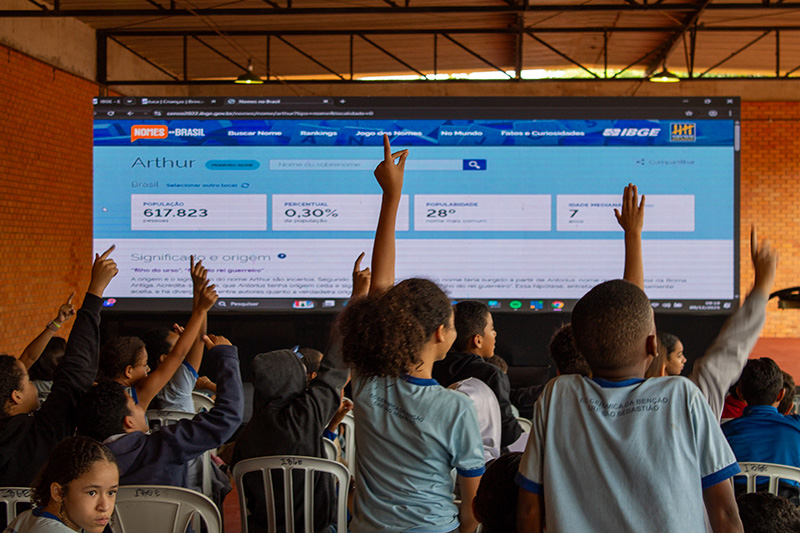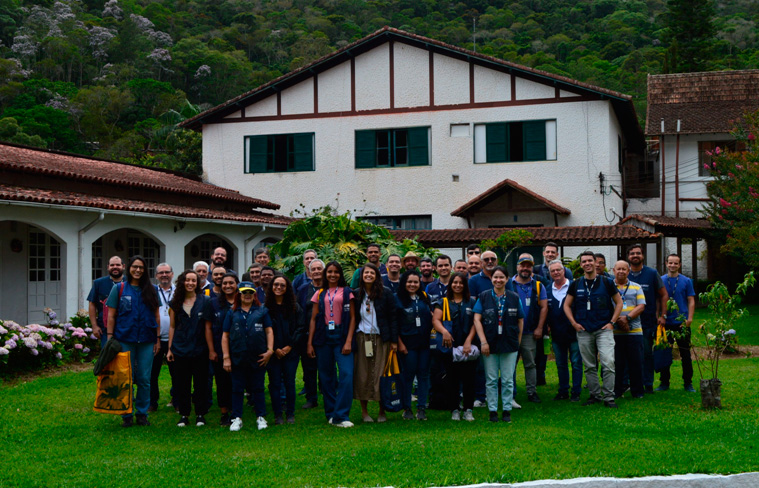Continuous PNAD
Education indicators advance in 2024, but school failure increases
June 13, 2025 10h00 AM | Last Updated: June 16, 2025 09h32 AM
Highlights
- In 2024, Brazil had 9.1 million illiterate persons aged 15 or over, corresponding to an illiteracy rate of 5.3%, the lowest in the time series that started in 2016. This rate fell from 6.7% in 2016 to 5.4% in 2023 and to 5.3% in 2024.
- The proportion of persons aged 25 and over who completed compulsory basic education in the country (at least high school) reached 56.0% in 2024, the highest percentage in the series that started in 2016 (46.2%). The proportion of persons with a higher education degree rose from 19.7% to 20.5% in the same period, its highest level in the time series.
- In 2024, average number of years of schooling for people aged 25 and over in Brazil reached 10.1 years, the highest in the series. In 2023, the average was 9.9 years, and in 2016, it was 9.1 years.
- The average schooling for women (10.3 years) continues to be higher than that for men (9.9 years). White people reached 11.0 years of schooling, and black or brown people, 9.4 years.
- Among children aged 6 to 14, 99.5% are in school, virtually the same rate as in 2016 (99.2%) and already universal. However, among young people aged 15 to 17, the rate was 93.4%, below the target set by the Law of Guidelines and Bases of National Education (LDB).
- In 2024, 94.5% of the children aged 6 to 14 were in primary school, the ideal level for this age group. This was the lowest rate in the time series, with a slight decline compared to 2023 (94.6%) and once again below the target (95.0%) set by the National Education Plan (PNE).
- Among youngster aged 14 to 29 in the country, 8.7 million had not completed high school in 2024, either because they dropped out of school without completing that level or because they had never attended it. In 2023, this figure was 9.3 million and in 2019, it reached 11.4 million.
- In 2024, among persons aged 15 to 29 in the country, 18.5% were not employed, nor were they studying or being trained. In 2023, this percentage was 19.8% and, in 2019, 22.4%.
- In 2024, among all persons in the country who attended at least one higher education course (whether or not having completed it), 72.6% had attended secondary school exclusively in the public system, and among those who at least attended a specialization, master's or doctoral program, 59.3% had attended secondary school entirely in public schools.
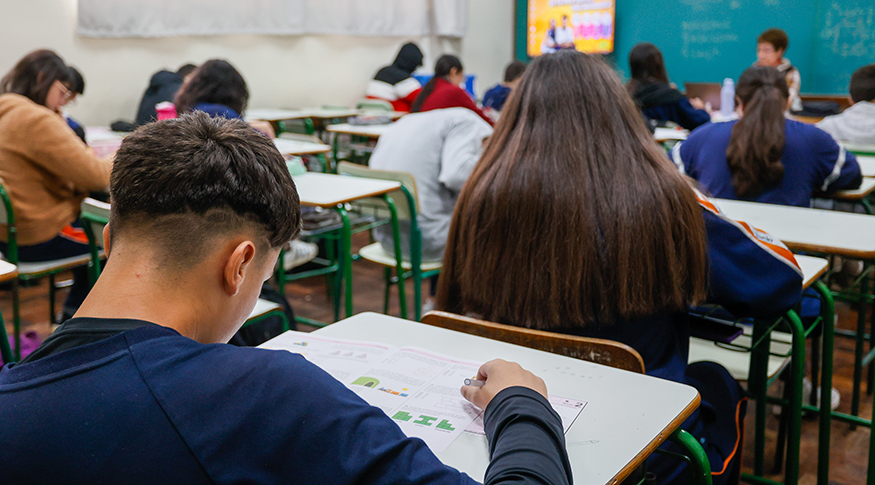
In 2024, Brazil had 9.1 million illiterate persons aged 15 or over, corresponding to an illiteracy rate of 5.3%, the lowest in the time series that started in 2016. This rate fell from 6.7% in 2016 to 5.3% in 2024. There was a drop of 0.1 percentage points against the rate in 2023 (5.4%), equivalent to 197 thousand fewer illiterate persons in the country during the period. Information comes from the annual module of the Continuous PNAD on Education, released today by the IBGE.
The Northeast concentrated 55.6% (or 5.1 million) of the country's illiterate persons, followed by the Southeast, with 22.5% (or 2.1 million persons).
In 2024, there were 5.1 million illiterate persons aged 60 and over in the country, which corresponds to a rate of 14.9% for this age group. Among the younger groups, the percentages decrease progressively: 9.1% among persons aged 40 and over, 6.3% among those aged 25 or over and 5.3% in the population aged 15 and over
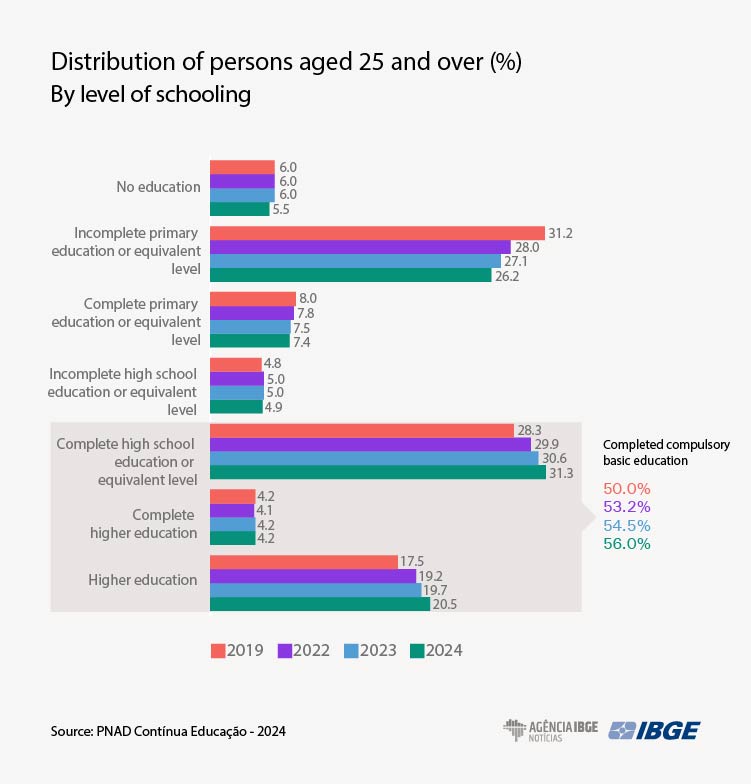
For William Kratochwill, an analyst at the IBGE, “these data indicate that illiteracy remains strongly associated with age. The new generations are having greater access to schooling and becoming literate in childhood. The difference of almost 10 percentage points between the illiteracy rates of the youngest and the oldest highlights this age-related nature and reinforces the importance of specific policies for adult literacy.”
In 2024, the illiteracy rate among women aged 15 and over was 5.0%, while that of men was 5.6%. The decrease from 2023 was 0.2 percentage points for women. For William, “the convergence of rates by sex, especially among the oldest, suggests progress in female schooling in the most recent generations, although the legacy of educational inequality from the past still remains.”
In 2024, 3.1% of white persons aged 15 or over were illiterate, while among black or brown persons in the same age group, the rate was 6.9%. The difference is more pronounced among the elderly: in the age group 60 or over, 8.1% of white persons were illiterate, compared to 21.8% among black or brown persons. The IBGE analyst notes that, “compared to 2023, there was a drop of 0.9 p.p. among black or brown persons aged 60 or over, an advance that did not significantly reduce the historical gap between the groups”.
In 2024, 3.1% of white persons aged 15 and over were illiterate, while among black or brown persons in the same age group, the rate was 6.9%. The difference is more pronounced among the elderly: in the age group 60 and over, 8.1% of white persons were illiterate, compared to 21.8% among black or brown persons. The IBGE analyst notes that, “compared to 2023, there was a drop of 0.9 p.p. among black or brown persons aged 60 and over, an advance that did not significantly reduce the historical gap between the groups”.
Compulsory basic education now reaches 56.0% of the persons aged 25 and over
In Brazil, the proportion of persons aged 25 and over who completed compulsory basic education – that is, completed high school or higher levels – reached 56.0% in 2024, the highest percentage in the time series that started in 2016 (46.2%).
In 2024, 57.8% of the women aged 25 and over had completed at least compulsory basic education, compared to 54.0% of men. From 2023, there was growth in both sexes, indicating a positive trend in access to schooling.
Among white persons, 63.4% had completed the basic educational cycle, against 50.0% of black or brown persons, resulting in a difference of 13.4 percentage points between these groups in 2024. William points out that “this difference has practically not changed since 2023, when it was 13.5 percentage points, reflecting the persistent inequalities in access to education”.
20.5% of the persons aged 25 and over in the country have completed higher education
The percentage of persons who completed high school rose from 30.6% in 2023 to 31.3% in 2024. And the proportion of persons who completed higher education rose from 19.7% to 20.5% in the same period. These two indicators are also at the highest level in the series that started in 2016.
At the other extreme, 5.5% of the persons aged 25 and over had no education, 26.2% had not completed primary education, 7.4% had completed primary education, and 4.9% had not completed high school. These four groups with completed primary education have been decreasing since 2016, reaching the lowest percentages in the time series in 2024.
Average years of schooling for persons aged 25 and over reaches 10.2 years
In 2024, the average years of schooling for persons aged 25 and over in Brazil was 10.1 years, above the 9.9 years in 2023. In 2016, the average was 9.1 years.
Women keep a higher average level of schooling (10.3 years) compared to men (9.9 years). Regarding color or race, the difference remains significant: white persons reached 11.0 years of schooling, while black or brown ones reached 9.4 years.
93.4% of the youngsters aged 15 to 17 are in school, a lower rate than that recommended by the LDB
In 2024, 10.4 million children aged 0 to 5 in the country were attending school or daycare. The school enrollment rate among children aged 0 to 3 reached 39.8% (or 4.4 million children), keeping the upward trend: 1.1 percentage points against 2023 and 9.5 percentage points against 2016. Among children aged 4 to 5, the school enrollment rate was 93.4%, with a slight increase from 2023 (92.9%), consolidating the broad coverage at this stage of early childhood education.
In the age group of 6 to 14, school enrollment reached 99.5% (or 26.2 million children), remaining practically stable since 2016 (99.2%) and evidencing the virtually full access to school in this age group. Among youngsters aged 15 to 17, the rate was 93.4%, still below the level set by the Law of Guidelines and Bases of National Education (LDB). In the groups aged 18 to 24 and 25 and over, the school enrollment percentages were 31.2% and 5.1%, respectively.
For William, “the stability of school enrollment in the younger age groups and its increase among children aged 0 to 3 years old indicate consistent progress in access to early childhood education. However, the fact that the rate among youngsters aged 15 to 17 years old has not yet reached universalization reinforces the need for policies to combat high school dropout.”
North and Northeast have the greatest shortage of daycare centers
In 2024, in Brazil, 63.6% of the children aged 0 to 1 and 53.3% of the children aged 2 to 3 who were not attending daycare were out of school by choice of their parents or guardians.
The second most cited reason was the lack of school/daycare in the area, lack of vacancies or refusal to enroll due to the child's age. Among children aged 0 to 1, 30.1% of the guardians pointed out this factor; among those aged 2 to 3, the percentage was 39.0%.
The North and Northeast stood out as the Maor Regions regions most affected by this type of limitation: in the North, 35.6% of the babies and 46.8% of the children aged 2 to 3 were out of daycare for this reason; in the Northeast, the percentages were 38.5% and 42.2%, respectively. For the IBGE analyst, “this demonstrates the greatest imbalance between supply and demand for schools/daycare centers or availability of places in early childhood education in these Major Regions”.
Country remains below PNE targets for reducing school failure
In 2024, 94.5% of the children aged 6 to 14 were attending elementary school, which is the ideal school stage for this age group. This slight decline in relation to 2023 (94.6%) is the lowest value in the series that started in 2016 and remains below the 95.0% target established by the National Education Plan (PNE).
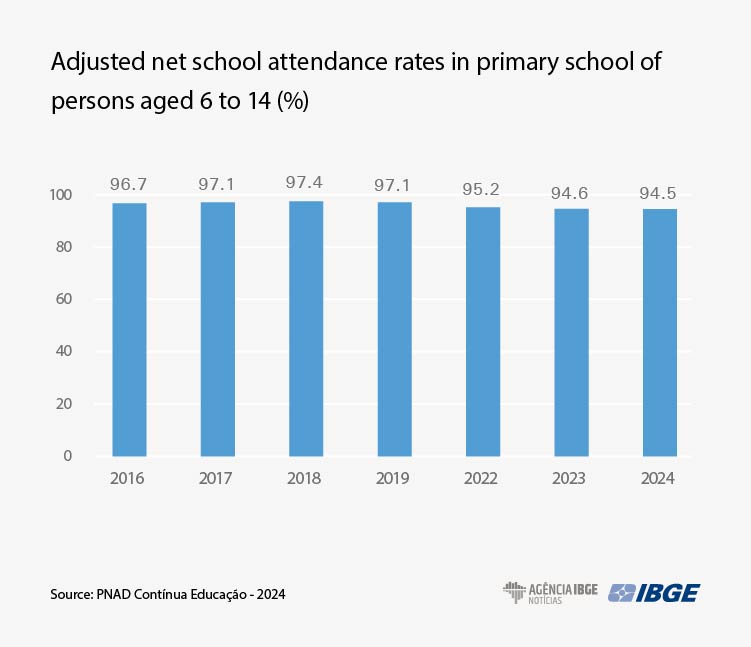
In the group aged 15 to 17, 76.7% were attending or had completed high school (the appropriate level for this age group) in 2024, an increase of 1.7 percentage points from 2023. Despite the progress, the indicator remains 8.3 percentage points below the 85% target set out in the PNE by 2024.
In 2024, the schooling rate for persons aged 18 to 24 was 31.2%, a slight increase compared to that in 2023 (30.5%). However, only 27.1% of these youngsters were attending the appropriate level for their age (higher education). The remaining 4.1% were behind in school. The proportion of young persons who were not attending school and had not completed the expected stage reached 64.6%, while only 4.2% were not attending because they had already completed higher education.
School failure is highest among black and brown persons
In the 18 to 24 age group, 37.6% of the white persons were studying and 37.4% were at the ideal level. Among black or brown persons in this age group, the schooling rate was 27.1%, with 20.6% at the ideal level.
The proportion of black or brown youngsters who were not attending school and had not completed the ideal level was 70.0%, while among white persons it was 56.2%, a difference of almost 14 percentage points, which shows an imbalance in this category. Furthermore, 6.2% of the white persons had already completed their undergraduate degree, compared to only 2.9% of the black or brown youngsters.
Goal 12 of the National Education Plan aims to increase the net attendance rate in higher education to 33% by 2024, but the percentage achieved by the country was 27.1%. The IBGE analyst notes that “goal 12 was surpassed only by white persons. Among black or brown persons, the numbers remain much lower than expected. The country's challenges involve reducing inequalities in access to higher education, addressing school failure and ensuring that youngsters remain in school”.
8.7 million youngsters have dropped out of or never attended school
Among youngsters aged 14 to 29, in the country, 8.7 million had not completed high school in 2024, either because they dropped out of school without completing this level or because they had never attended it. Of these youngsters, 59.1% were men and 40.9% were women, 26.5% were white and 72.5% were black or brown. In 2023, this figure was 9.3 million and in 2019, it reached 11.4 million.
In this age group, the highest dropout rates occurred from the age of 16: 16.5% at this age, 19.9% at 17 and 20.7% at 18. Even so, early school dropout rates are still present at the ages corresponding to primary school: 6.5% had left school by the age of 13 and 6.8% at the age of 14.
Early dropout rates up to the age of 13 were highest in the Northeast (7.8%) and the North (6.1%), but the South (5.9%) also had significant rates.
The dropout rate before the age of 14 (13.3% in total) indicates dropouts during primary school, a level that should be widely accessible. However, the major milestone in the school transition continues to be the age of 15, when the dropout rate reaches 12.6%, almost twice as the rate at the age of 14 (6.8%). William highlights that “this may be linked to the perception of the usefulness of secondary education or, even, to the need of early entry into the job market”.
Work, lack of interest and pregnancy keep youngsters away from school
In 2024, the main reason for youngster aged 14 to 29 to drop out of school or never have attended school was the need to work, mentioned by 42.0% of those interviewed. The second most cited reason was not being interested in studying (25.1%).
Among men aged 14 to 29 who dropped out or had never attended school, the main reason reported was the need to work (53.6%). Next came lack of interest in studying (26.9%) and permanent health problems (4.2%).
Among women, the most cited reason was the need to work (25.1%). Next came pregnancy (23.4%) and lack of interest (22.5%). In addition, 9.0% of them indicated doing household chores or caring for other people. Among men, only 0.8% mentioned this reason for dropping out of school. For the IBGE analyst, “these results show that, in addition to economic conditions, reproductive and domestic responsibilities are still among the main obstacles to young women staying in school. For men, the assignment to paid work is the most important factor for dropping out of school.”
18.5% of the youngsters aged 15 to 29 in the country did not work or study or were seeking qualification
In 2024, among the 48.0 million persons aged 15 to 29 in the country, 18.5% were not employed, not studying and not seeking qualification. In 2023, this percentage was 19.8% and, in 2019, it reached 22.4%. The proportions of youngsters in this age group who were employed and not studying or seeking qualification followed the opposite trend: they went from 37.3% in 2019 to 39.4% in 2023, reaching 39.9% in 2024.
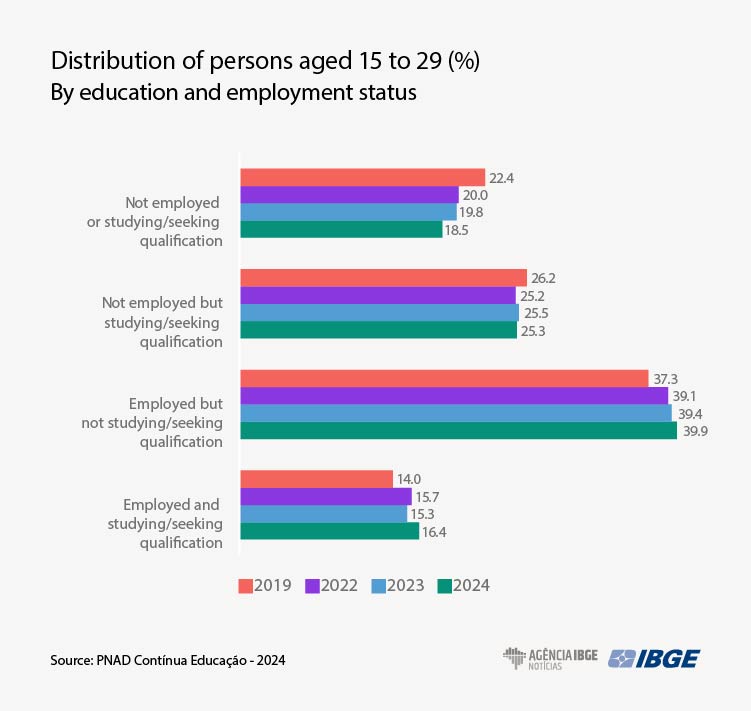
Among women, 24.7% were not employed, studying or seeking qualification, and among men, this percentage was 12.5%. As for color or race, the percentage of black or brown persons who were not studying, not seeking qualification and not employed (21.1%) was considerably higher than that of white persons in the same condition (14.4%).
The proportion of persons who were not employed, studying or seeking qualification varied greatly with age: it was only 4.0% in the 15 to 17 age group, rose to 22.4% in the 18 to 24 age group and fell to 21.0% in the 25 to 29 age group.
Between 2019 and 2024, the number of persons attending technical high school grew by 28.8%
In 2024, among the 9.0 million high school students in the country, 9.2% were attending a technical high school course or a regular course (teaching) compared to 7.0% in 2019. The number of persons attending technical high school reached 832 thousand, 28.8% more than in 2019, when 646 thousand persons were attending this type of course.
In 2024, the number of persons aged 14 and over who studied up to elementary school (regular or youth and adult education) and those who attended at most high school or an equivalent course without completing it was 71.5 million, 2.3% less than in 2023 (73.2 million). Despite this reduction, those attending a professional qualification course increased by 8.8% from 2023 to 2024, reaching 569 thousand students.
From 2023 to 2024, attendance to professional qualifications courses grew by 8.8%
In 2024, the number of persons aged 14 and over who studied up to elementary school (regular or youth and adult education) and those who attended at most high school or an equivalent course without completing it was 71.5 million, 2.3% less than in 2023 (73.2 million). Despite this reduction, those attending a professional qualification course increased by 8.8% from 2023 to 2024, reaching 569 thousand students.
In 2024, the category other private institution, which historically is the main location for professional qualification courses, was chosen by 47.4% of students. Institutions of the National Learning Services accounted for 21.4%, while 18.5% of students took the course at a public institution, and 12.8%, at the company where they worked.
72,6% dos que já haviam frequentado o nível superior cursaram o nível médio na rede pública
PNAD also showed that, in 2024, among all the persons in the country who had attended at least higher education, 72.6% (almost three in four) had attended secondary school exclusively in the public system.
Similarly, among all the persons in the country who had already attended at least one specialization, master's or doctorate program, 59.3% had attended high school entirely in public schools.
For the IBGE analyst, “these results indicate the capacity of the public system to form human capital to advance to higher levels of education, such as undergraduate and graduate studies. Although international exams highlight the need for improvements in public education, this result is a clear sign that students in the public system have real chances of accessing higher education”.
More about the survey
Besides short-term data on the labor market, the Continuous National Household Sample Survey (Continuous PNAD) investigates, annually, relevant structural topics that help explain the Brazilian reality. In the Education module, this survet analyzes the illiteracy rate of persons aged 15 and over, the level of schooling and the average number of years of schooling of persons aged 25 and over and the adjusted net school attendance rates, besides studing conditions and employment status of persons aged 15 to 29, among other indicators.
Since the second quarter of 2020, starting year of the pandemic, the IBGE changed the form of data collection, from face-to-face to telephone interviews, lasting until the end of the second semester of 2021. Among the impacts of this form of data collection, there was considerable reduction in the rsample utilization rate, in 2020 and 2021. Due to the lack of information, the time series of the survey covers the period 2026-2019 and 2022 to 2024.



